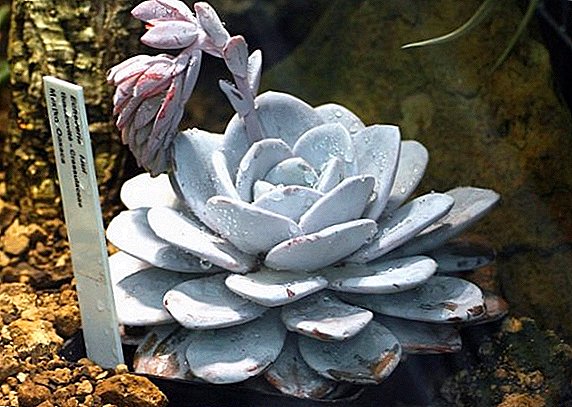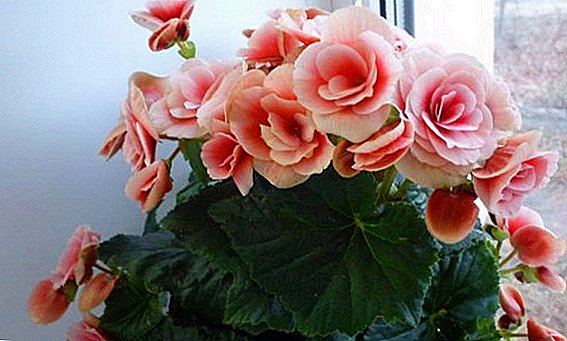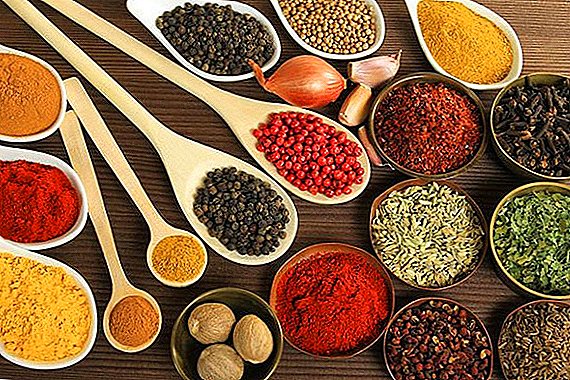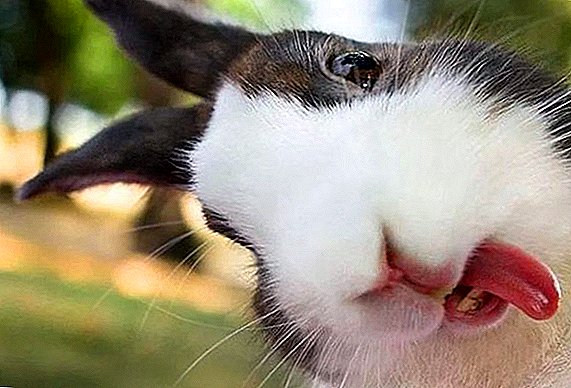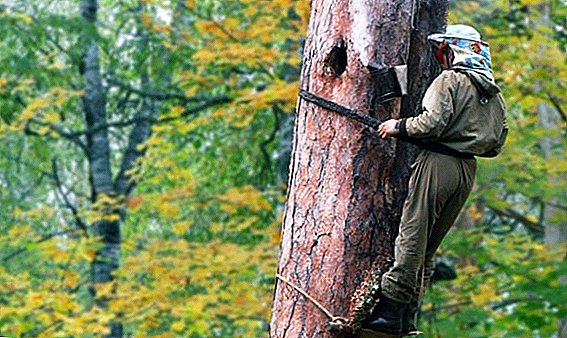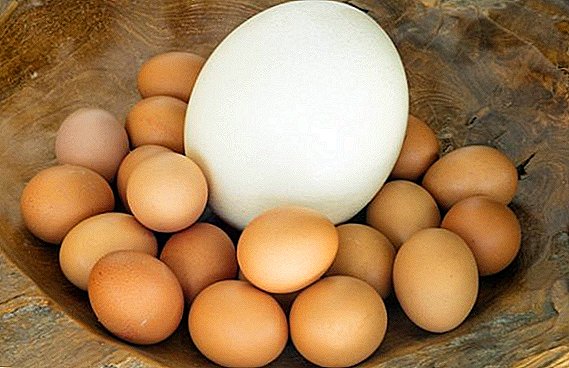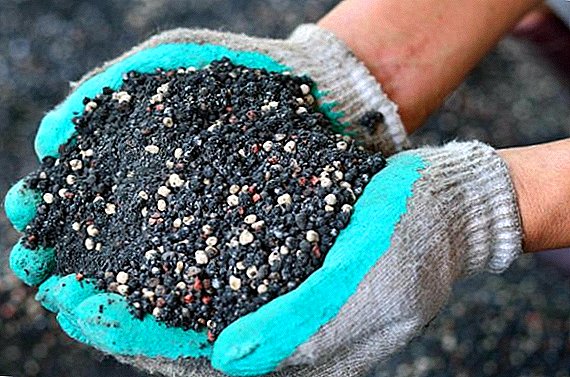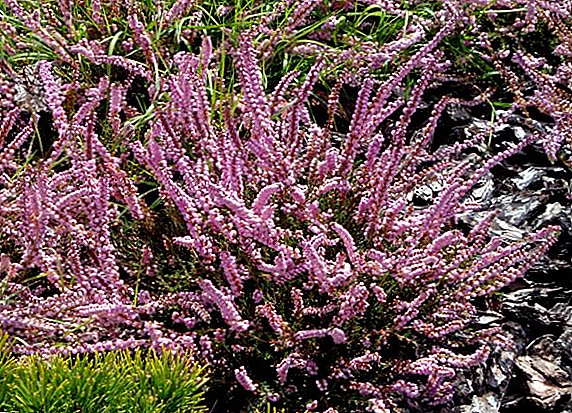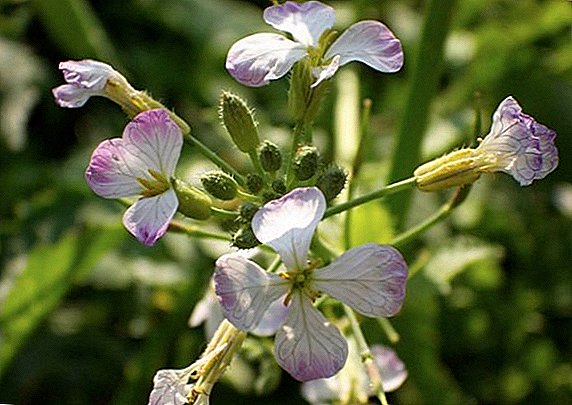 In the meadows and fields of our country often there is a wild radish - a lush grassy one-year weed. Fills all free space, regardless of the soil composition and climatic conditions. Wild radish is a poisonous plant, but it also has beneficial medicinal properties.
In the meadows and fields of our country often there is a wild radish - a lush grassy one-year weed. Fills all free space, regardless of the soil composition and climatic conditions. Wild radish is a poisonous plant, but it also has beneficial medicinal properties.
Botanical description
Wild radish is an annual cruciferous plant, its Latin name is Raphanus raphanistrum. The plant is considered weedy and widespread throughout our country, especially in the southern and eastern regions.
Weed grows in abandoned areas, roadsides, in fields of agricultural crops, pastures, on the banks of water bodies, floodplains and open forests in temperate, subtropical, semi-arid, and sometimes tropical regions.
Roots, leaves and flowers
 Annual herb with a vertically growing herbaceous stem usually reaches 40-60 cm in height. The root system is shallow and weakly branched. Wild radish forms a basal rosette of large, deep-fingered leaves in the early stages of growth. Its smaller and narrower upper leaves are alternately arranged on the stem and have fewer blades than the lower leaves of the plant.
Annual herb with a vertically growing herbaceous stem usually reaches 40-60 cm in height. The root system is shallow and weakly branched. Wild radish forms a basal rosette of large, deep-fingered leaves in the early stages of growth. Its smaller and narrower upper leaves are alternately arranged on the stem and have fewer blades than the lower leaves of the plant.
The annual may have white, pale yellow, lilac, pink, or less often purple flowers (18–40 mm in diameter) that have four petals. Flowers are arranged in loose elongated clusters on the tips of grassy branches. Annual bloom at the beginning of summer.
Wild radish stems are round or slightly lanceolate, may have a color from bluish-green to purple. Stems can be unbranched or form several long branches near the base of the plant.
Learn how in traditional medicine weeds are used: white mart, European dodder, field thistle, ragweed, amaranth upturned, spurge, dandelions, thistle.
The leaves are green or bluish-green, covered with fine, hard hairs and slightly rough to the touch. The lower (rosette) leaves of the plant are large (from 15-30 cm in length and 5-10 cm in width), located higher along the stem, have narrow and jagged edges. The higher to the top of the plant, the smaller and smaller the leaves are.  Breeding
Breeding
- At the end of flowering, elongated seed pods are formed on the plant (3–9 cm long and 3–6 mm wide). Seed plants are attached to wild radish stems 1-3 cm long and ends with a tapering "beak" (1-3 cm long). The boll is divided into several segments. Seed plants resemble a pod, in which they find pea seeds. A seed pod has a green or purple color when it is immature, and becomes yellowish brown or grayish as it matures.
- When the pods with seeds fully ripen, they are easily split into 3-10 segments (3-7 mm long and 2-5 mm wide). Moreover, each segment contains one seed. The seeds are almost round in shape, their diameter is from 1.5 to 4 mm, red or yellowish-brown. During the season, from 150 to 300 seeds ripen on the annual. Fallen seeds on the ground germinate only a year later, after winter stratification in natural conditions.
- Wild radish is propagated only by seeds that extend to some distance from the mother plant due to wind, water, animals and humans. It is believed that the spread of the seeds of this weed over long distances is due to contaminated weeds grain (wheat, oats, rye).
 In agriculture, on the cultivated fields, they regularly fight this weed, as vegetable crops or grains grow longer than wild radish seeds. If time does not take action and does not destroy the unwanted inhabitants of the field, the weed will grow and will not allow bread or potatoes to grow. In private farms, gardeners destroy wild radish by hand weeding; in large areas, their reproduction is kept under control with the help of herbicidal treatments.
In agriculture, on the cultivated fields, they regularly fight this weed, as vegetable crops or grains grow longer than wild radish seeds. If time does not take action and does not destroy the unwanted inhabitants of the field, the weed will grow and will not allow bread or potatoes to grow. In private farms, gardeners destroy wild radish by hand weeding; in large areas, their reproduction is kept under control with the help of herbicidal treatments.Did you know? The ancient Egyptians regarded radish as food for people of low descent. Basically, it fed the workers who built the pyramids in the Valley of the Kings.
What is the danger
Wild and cultured radish are very similar to each other, but the wild relative inflorescences are poisonous. When wild radish blooms, it becomes very toxic. Only after the stems and leaves are thoroughly dried will they lose their poisonous qualities.
Despite its poisonous qualities, in folk medicine for the treatment of diseases use the crow's eye, yew berry, wolfberry, hogweed, common ivy, dodder, grass flax, belladonna.
 When the plant blooms, mustard oils are produced in its above-ground parts (stems, leaves and flowers), which are a source of poisonous substances. If during flowering greens or wild mustard flowers are added to any culinary dish, then consumers can get seriously poisoned.
When the plant blooms, mustard oils are produced in its above-ground parts (stems, leaves and flowers), which are a source of poisonous substances. If during flowering greens or wild mustard flowers are added to any culinary dish, then consumers can get seriously poisoned.
The root of wild radish can not be eaten regardless of the flowering plants, it is very toxic.
Signs of poisoning:
- the body is subjected to severe intoxication;
- urine color changes to bright yellow or orange;
- a person is prone to nausea and vomiting;
- rapid heartbeat;
- dizzy;
- irreversible changes occur in the kidneys.
What to do in case of poisoning
- Flush the stomach - give plenty of drink to the victim (4 drops of ammonia are added per liter of water) and then induce vomiting.
- Wash the intestinal tract - to perform climatic conditioning with warm water with the addition of manganese (pale pink water).
- If the heart hurts or arrhythmia is clearly felt, give cardiological preparations to the victim (validol, nitroglycerin).
- It will be good if the victim drinks 1-2 liters of freshly brewed medium-thick jelly (it wraps around the stomach walls and relieves inflammation).
- A cold (not icy) compress is placed on the patient's stomach.
- After these actions are taken, immediately call an ambulance.
 The British traditionally use the green part of this plant for the preparation of salads, seasonings and first courses. True, they do it at the moment when the plant blooms. They eat wild radish only fresh, because after undergoing heat treatment the plants have a bitter taste. The above-ground part of wild radish is specially dried for cooking culinary seasonings.
The British traditionally use the green part of this plant for the preparation of salads, seasonings and first courses. True, they do it at the moment when the plant blooms. They eat wild radish only fresh, because after undergoing heat treatment the plants have a bitter taste. The above-ground part of wild radish is specially dried for cooking culinary seasonings.As seed pods form and seeds ripen in them, this weed becomes dangerous for herbivores (goats, cows, rabbits and nutria). If you mistakenly feed the animals with this weed, then the mustard oils contained in it will lead to acute lesions of the gastrointestinal tract and the death of pets.
Important! Animal breeders can be misled by the external similarity of wild radish and field mustard. It should be extremely attentive.
Beneficial features
The main reason for changes in health during this period is an acute shortage of vitamins. This deficiency can be replenished with the help of pharmacy vitamin complexes or obtain nutrient minerals from a weed plant - wild radish.
The beneficial substances found in this plant are:
- minerals;
- essential oils;
- vitamins;
- potassium;
- phosphorus;
- iodine;
- iron;
- calcium;
- sodium salt.
 Vitamin C is contained in its aerial parts (stems and leaves), and the ripened seeds are a source of vegetable oils, the percentage of which in the ripened seeds of wild radish reaches 32%.
Vitamin C is contained in its aerial parts (stems and leaves), and the ripened seeds are a source of vegetable oils, the percentage of which in the ripened seeds of wild radish reaches 32%.Beneficial features:
- antimicrobial;
- bactericidal;
- expectorant;
- antiscorbetic;
- antianemic;
- antibacterial.
Did you know? The ancient Greeks believed radish king-vegetable and cast it in gold in full size. It was an offering to the god Apollo at the annual Delphic celebrations.The plant contributes to:
- fast metabolism (metabolism);
- increases the body's production of saliva and gastric juice;
- works as a diuretic, thereby eliminating puffiness;
- improves the gastrointestinal tract;
- removes toxins from the body, preventing them from entering the liver.

Familiarize yourself with the beneficial properties of black, green, white radish.
Long since this weed is applied in traditional medicine. On its basis, medicinal drugs are prepared, with the help of which they eliminate many health problems.
What diseases are treated in folk medicine wild radish:
- poor eyesight;
- cough;
- anemia;
- colds;
- pain in muscles and joints;
- arthritis or sciatica;
- malaria;
- scurvy and bleeding gums;
- impotence in old age;
- poorly healing (inflamed, festering) wounds;
- heart arrhythmia;
- prevention of atherosclerosis;
- reduced lactation during lactation.
Important! Self-treatment with dangerous herbs is unacceptable! It is imperative that you seek advice from your local GP.Who should not be used:
- sick gastritis;
- people with diagnoses: gastric or duodenal ulcer.
 Wild Radish Salad Recipe
Wild Radish Salad RecipeIngredients for Salad:
- leaves of wild radish - 200 g;
- green onion feathers - 150 g;
- parsley leaves - one bunch;
- green dill - one bunch.
- eggs - 2 pcs .;
- sour cream - 0.5 cup;
- sugar - 1 tbsp. spoon;
- salt - 0.5 tsp;
- Sunflower oil - 1 tbsp. spoon;
- vinegar - 1 tbsp. spoon.
Cooking sauce: raw yolks of two eggs are mixed with sour cream, sugar, sunflower oil, vinegar and salt are added to the same place. 
Did you know? There are Asian varieties of radish: Chinese radish (lobo), its taste has a similarity to the taste of ordinary radishes, and Japanese radish (daikon) - this differs from all varieties by the record length of the thick root. Japanese radish can reach a weight of three kilograms.This weed is an excellent honey plant - a source of nectar and pollen for bees' toilers. Beekeepers are trying to take the apiary to the summer camp near the places where wild radish grow in abundance. Some enthusiasts even deliberately scatter the seeds of this plant collected in the places of the future honey harvest.
Wild radish - a storehouse of minerals and vitamins, it can and should be eaten. But you should always remember about the existing danger of poisoning this plant of people and animals.


